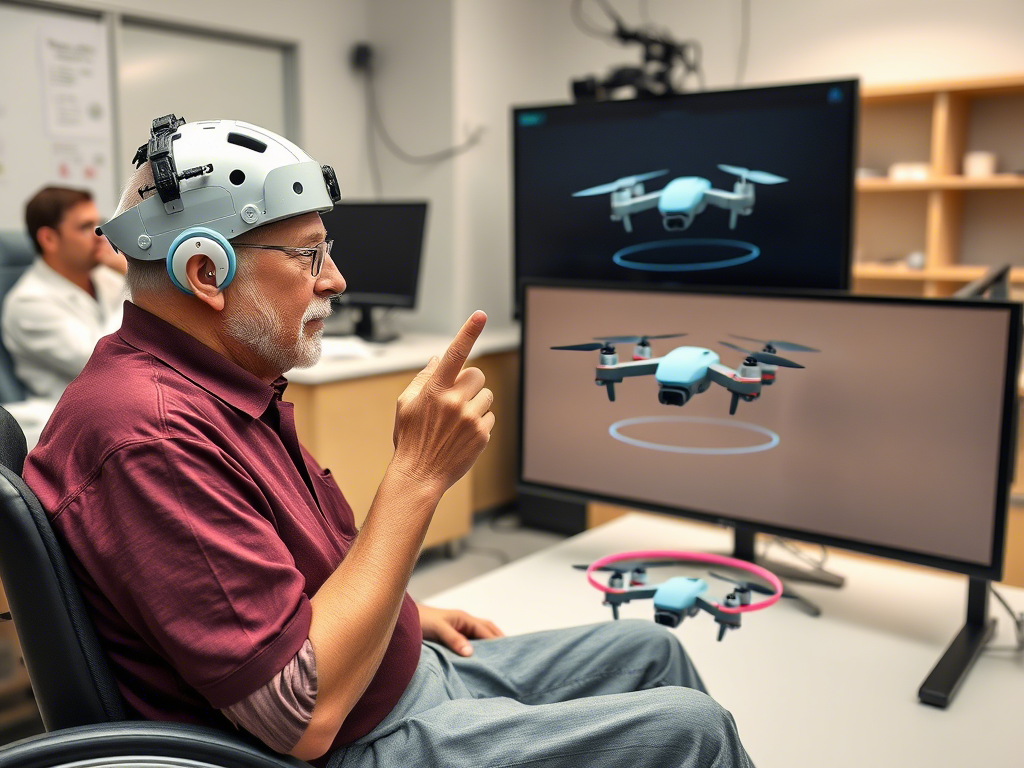From Krang to Real Life: A Tetraplegic Man Pilots a Drone with His Thoughts, Ushering in a New Era of Human-Machine Collaboration
Introduction: The Sci-Fi Dream Becomes Reality
Imagine controlling machines with your mind—no buttons, no joysticks, just pure thought. It sounds like something straight out of a science fiction movie or comic book (think Krang from Teenage Mutant Ninja Turtles). But today, this futuristic vision is becoming a reality thanks to groundbreaking advancements in brain-computer interface (BCI) technology.
In a recent milestone, researchers enabled a 69-year-old tetraplegic man to pilot a virtual drone using only his thoughts. By imagining specific finger movements, the participant sent neural signals to an AI-powered system that translated his intentions into precise drone controls. This achievement not only fulfills the man’s lifelong dream of “flying” but also demonstrates the immense potential of BCIs to transform lives and redefine human capabilities.
The Technology Behind the Breakthrough
At the core of this innovation lies a cutting-edge implant developed by Blackrock Neurotech. Embedded with 192 electrodes, the device captures high-resolution neural activity from the motor cortex—the part of the brain responsible for movement. Spearheaded by neurosurgeon Dr. Matthew Willsey at the University of Michigan, the project showcases how far neuroscience and artificial intelligence have come in decoding the language of the brain.
Here’s how it works:
- Neural Signal Capture: When the participant imagines moving his fingers, the implant records electrical activity in the motor cortex.
- AI Translation: Advanced algorithms interpret these signals and map them to specific commands, such as steering the drone left or right.
- Real-Time Execution: The translated commands are sent to the drone, allowing the user to control its flight path seamlessly.
This process highlights the incredible synergy between biology and technology, turning abstract thoughts into tangible actions.
Beyond Drones: The Broader Implications
While flying a virtual drone is undeniably impressive, the applications of this technology extend far beyond aviation. Here are some areas where BCIs could make a profound impact:
1. Empowering Individuals with Disabilities
For people living with paralysis or other mobility impairments, BCIs offer newfound independence. Imagine being able to:
- Control robotic limbs with precision.
- Type messages or browse the internet using thought alone.
- Operate household appliances without physical intervention.
These possibilities open doors to greater autonomy and quality of life for millions worldwide.
2. Creative Expression
Artists, musicians, and writers could harness BCIs to create directly from their minds. For instance:
- Painters might visualize their artwork and see it materialize on a digital canvas.
- Composers could compose symphonies simply by imagining melodies.
- Writers could draft novels without ever touching a keyboard.
This fusion of creativity and technology has the potential to revolutionize artistic expression.
3. Advancing Robotics and Automation
As BCIs improve, they could enhance human interaction with robots in industries like manufacturing, healthcare, and space exploration. Surgeons, for example, could perform delicate procedures remotely with unparalleled accuracy, while astronauts might control machinery on distant planets through thought alone.
4. Gaming and Virtual Reality
Gamers could immerse themselves in fully interactive worlds, navigating environments and completing tasks purely through mental commands. This would take gaming immersion to unprecedented levels, making traditional controllers obsolete.
Ethical Considerations: Navigating the Brave New World
With great power comes great responsibility. As BCIs become more advanced, several ethical concerns arise:
- Privacy: If our thoughts can be read by machines, how do we protect them from misuse?
- Autonomy: Who controls the development and deployment of BCIs? Could they be weaponized or exploited?
- Equity: Will this technology be accessible to everyone, or will it deepen existing social divides?
- Identity: How does integrating machines with our brains affect our sense of self?
Addressing these questions will require careful regulation, transparent policies, and ongoing public dialogue.
Looking Ahead: A Transformative Future
The convergence of neuroscience, AI, and robotics is ushering in a new era where the boundaries between humans and machines blur. From restoring lost abilities to enhancing natural ones, BCIs hold the promise of unlocking untapped human potential.
But perhaps the most exciting aspect is the unknown. Just as smartphones transformed communication in ways we couldn’t predict two decades ago, BCIs may lead to innovations we can’t yet imagine. Whether it’s downloading skills Matrix-style, communicating telepathically, or exploring augmented realities, the possibilities are limitless.
Embracing the Strange Future
The future truly is stranger—and more exciting—than fiction. Technologies like BCIs remind us that what was once confined to the pages of sci-fi novels is now within reach. While challenges remain, the potential benefits are too significant to ignore.



